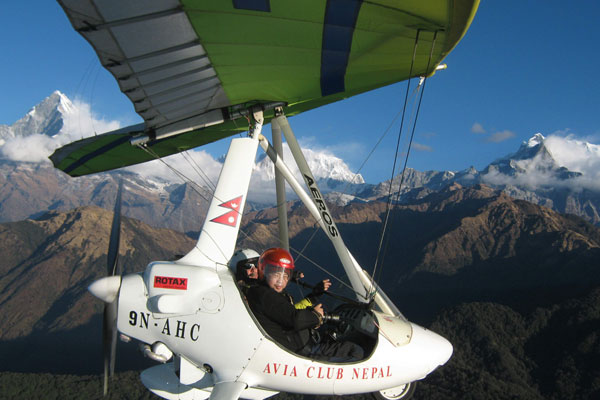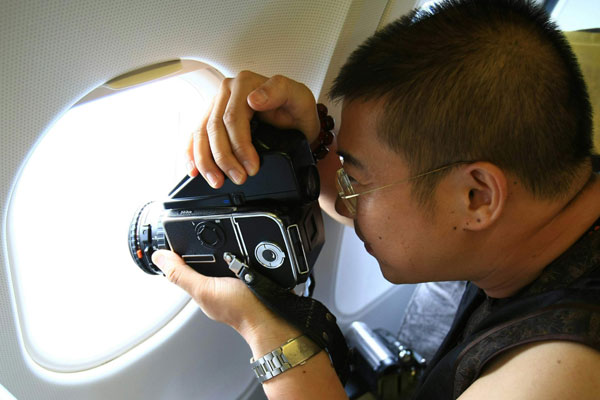Eye in the sky
Updated: 2012-10-18 08:23
By Zheng Jinran (China Daily)
|
||||||||
An aerial photographer presents a panoramic view of the need for environmental protection. Zheng Jinran reports in Beijing.
 |
|
Wang Chen shoots aerial photos of Nepal's snow mountains in January 2010. Photo Provided to China Daily |
If Wang Chen isn't working in his office, he's in the sky, camera in hand.
The entrepreneur from Guangdong province's Shenzhen has spent the past nine years shooting aerial photographs in more than 40 countries, as well as the North and South poles, recording environmental changes to create public awareness of the need for protection.
The 47-year-old majored in photography in university and founded a photographic printing and publishing company in 1983.
He has since continued publishing books of his snapshots.
"Photography is my life," Wang says.
"It has gone beyond being a hobby to becoming my religion. I believe in it so strongly that I'm willing to sacrifice for it."
He entered the field by shooting landscape photographs. "But I didn't feel any accomplishment from that," he says.
Everything changed the first time he saw an aerial photograph in 1986, he says.
The image showed the silhouette of a bird's back as it flew over an island.
"It was enlightening, and I took so much from it that I decided to do aerial photography myself," he recalls.
But because of practical obstacles, such as finances, it took him 17 years to realize this dream.
Wang traveled to the Hengduan Mountains in Southwest China in 2003 and shot photos of them from a helicopter hovering above 6,000 meters.
Hengduan's peaks range from 1,300-6,000 meters in altitude and are rich in biodiversity.
 |
| Wang Chen takes every chance he gets to shoot when he's in the sky. Photo Provided to China Daily |
"While I got an unbearable headache, I also got marvelous pictures," Wang says.
"It was a new start in life because it was a new way to discover and express my feelings about nature."
He says the experience was so exceptional that he remembers every detail of it down to the camera model.
From that day on, Wang was obsessed.
He spent the following three years flying over all of the country's major topographical wonders, including the Qaidam Basin and the Qinghai-Tibet Plateau, and many large cities, including Guangdong province's Shenzhen, Zhejiang's provincial capital Hangzhou and Hong Kong.
In 2007, he started flying over other countries and regions to broaden his horizons and globalize his photographic mission to advocate environmental protection.
Wang sometimes rents private planes with two or three friends and flies above 9,000 meters. He usually suffers intense headaches during the two-hour trips because of the high altitude.
It can be dangerous.
He recalls their helicopter was struck by lightening when they flew over Cambodia in 2009, causing the aircraft to suddenly plummet 50 meters. "The pilot was struck speechless for 10 minutes," Wang recalls.
"But the worst was when one of my companions died, when our car tumbled into the Lancang River as we were driving to take aerial photos about 10 years ago."
He says he takes every chance he gets to shoot.
"I've witnessed the deterioration of China's environment over the years," he says.
"This has compelled me to zoom in on protection advocacy by recording a bird's-eye view of pristine landscapes being destroyed by such activities as mining."
Wang says a comparison of the photos he took in Sweden and Denmark against those from China shows much cleaner mining wastewater in Scandinavia.
"I'll collect my photos that chronicle these issues from the past 14 years and publish them to reveal the scars humankind is inflicting on our planet," he says.
He has published three albums in a series called Earth and plans to release 10 in total. "The fourth one - tentatively called The Master of Earth - will be published in November to record humankind's impact on the planet," he says.
Wang's friend Liu Yanli, who's an enthusiastic environmentalist, says Wang's success as a photographer and environmentalist comes about because he's a goal-oriented person who's determined to realize his aspirations.
"His work, especially that comparing specific sites within a theme, can play a larger role in elevating public awareness," she says.
His vision has expanded to involve his large group of friends, who formed an association to enable more people to participate in the mission in 2004. Wang is the founder and secretary-general of the Shenzhen Enterprises Photography Association, which has more than 2,000 members, most of whom are entrepreneurs who enjoy photography.
Wang is also a member of Shenzhen's committee of the Chinese People's Political Consultative Conference.
He used this opportunity to present to the advisory organization in 2011 a series of his aerial photos that show the worsening of the city's air pollution. His presentation received government feedback and raised public awareness about PM 2.5.
"I'll make full use of my photos in the future to advocate for greater environmental protection."
Wang keeps extremely busy in his capacities as an entrepreneur, photographer, environmentalist and CPPCC delegate. Over the past nine years, Wang has spent more than 1 million yuan ($159,000) on shooting aerial photographs.
"My family knows me and understands I can't give up my faith in the power of photography, so they support me very much," he says.
"I feel sorry for my family, especially my daughter. I'll spend as much time with them as I can after I turn 60 and am too old to do this anymore."
Contact the writer at zhengjinran@chinadaily.com.cn.

 Relief reaches isolated village
Relief reaches isolated village
 Rainfall poses new threats to quake-hit region
Rainfall poses new threats to quake-hit region
 Funerals begin for Boston bombing victims
Funerals begin for Boston bombing victims
 Quake takeaway from China's Air Force
Quake takeaway from China's Air Force
 Obama celebrates young inventors at science fair
Obama celebrates young inventors at science fair
 Earth Day marked around the world
Earth Day marked around the world
 Volunteer team helping students find sense of normalcy
Volunteer team helping students find sense of normalcy
 Ethnic groups quick to join rescue efforts
Ethnic groups quick to join rescue efforts
Most Viewed
Editor's Picks

|

|

|

|

|

|
Today's Top News
Health new priority for quake zone
Xi meets US top military officer
Japan's boats driven out of Diaoyu
China mulls online shopping legislation
Bird flu death toll rises to 22
Putin appoints new ambassador to China
Japanese ships blocked from Diaoyu Islands
Inspired by Guan, more Chinese pick up golf
US Weekly

|

|






